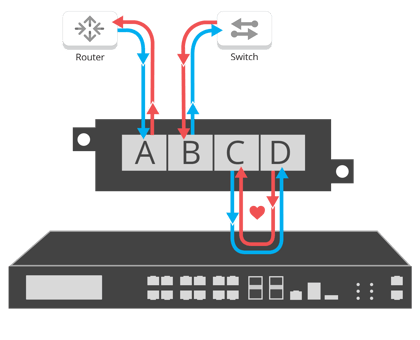

One of the key vital signs medical professionals routinely check to determine the health state of your body’s inline device (heart) is to measure blood pressure. During each heartbeat, blood pressure varies between a maximum (systolic) and a minimum (diastolic) pressure. They check the pressure of the blood entering the heart and also the pressure as it exits. In other words they check it bi-directionally.
 We use Heartbeat packets (HB) in our EdgeSafe: Bypass TAPs in a similar manner: to check the health of an active inline device like an IPS (Intrusion Detection System) or NGFW (next-gen firewall). We check the status of the link going into the device and also the link coming from the device to monitor the health of the device itself. Other manufacturers may only check HBs in one direction.
We use Heartbeat packets (HB) in our EdgeSafe: Bypass TAPs in a similar manner: to check the health of an active inline device like an IPS (Intrusion Detection System) or NGFW (next-gen firewall). We check the status of the link going into the device and also the link coming from the device to monitor the health of the device itself. Other manufacturers may only check HBs in one direction.
The concept of Heartbeat packets in our Bypass TAPs is simple, but the protection they provide your network is invaluable, much like why your doctor tests the “links” as well as the health, of your body’s “inline device” to prevent a serious failure in your body’s network.
The way it works is that the east bound live network traffic enters the TAP. A Heartbeat packet is added by the Bypass TAP to the data, and both are sent out to the input port of the inline device. The inline device performs its task and then sends the data back into the TAP with the Heartbeat. The Heartbeat is stripped out by the TAP, (HBs are never sent into the live network) and the data is sent out of the TAP and back into the live network. This would be normal operation, where the TAP is always invisible to the network.

Sometimes, the inline device needs to be taken offline for a number of reasons: reboot, software/firmware updates, maintenance, replacement, or even failure. If the HB sent from the TAP is not received back to the TAP, indicating the inline device is offline, the TAP will immediately bypass the device (fail safe). That is, the east traffic entering port A of the TAP will automatically be connected to the west traffic out port B and the network will continue to stay up despite the fact the inline device is offline. No network downtime. No single point of failure.
After the maintenance is performed or the issue is resolved, and the inline device is back on line, the HBs will again be detected by the TAP, and the TAP will automatically start routing the traffic back through the inline device resuming normal activity
Using a Bypass TAP with bidirectional heartbeats monitors the health of your inline device and helps prevent catastrophic failure in your network. Much like regularly testing your blood pressure ensures your personal health and helps to avoid an even more catastrophic failure.
Looking to add a bypass solution to your security deployment, but not sure where to start? Join us for a brief network Design-IT consultation or demo. No obligation - it’s what we love to do!
If the inline security tool goes off-line, the TAP will bypass the tool and automatically keep the link flowing. The Bypass TAP does this by sending heartbeat packets to the inline security tool. As long as the inline security tool is on-line, the heartbeat packets will be returned to the TAP, and the link traffic will continue to flow through the inline security tool.
If the heartbeat packets are not returned to the TAP (indicating that the inline security tool has gone off-line), the TAP will automatically 'bypass' the inline security tool and keep the link traffic flowing. The TAP also removes the heartbeat packets before sending the network traffic back onto the critical link.
While the TAP is in bypass mode, it continues to send heartbeat packets out to the inline security tool so that once the tool is back on-line, it will begin returning the heartbeat packets back to the TAP indicating that the tool is ready to go back to work. The TAP will then direct the network traffic back through the inline security tool along with the heartbeat packets placing the tool back inline.
Some of you may have noticed a flaw in the logic behind this solution! You say, “What if the TAP should fail because it is also in-line? Then the link will also fail!” The TAP would now be considered a point of failure. That is a good catch – but in our blog on Bypass vs. Failsafe, I explained that if a TAP were to fail or lose power, it must provide failsafe protection to the link it is attached to. So our network TAP will go into Failsafe mode keeping the link flowing.
Single point of failure: a risk to an IT network if one part of the system brings down a larger part of the entire system.
Heartbeat packet: a soft detection technology that monitors the health of inline appliances. Read the heartbeat packet blog here.
Critical link: the connection between two or more network devices or appliances that if the connection fails then the network is disrupted.